Service hotline
+86 0755-83044319
release time:2024-03-11Author source:SlkorBrowse:24088
Vehicle-mounted radar is one of the core sensors of Advanced Assisted Driving (ADAS) and unmanned driving, and the vehicle-mounted radar chip is the core of vehicle-mounted radar. Nowadays, the highly integrated (MMIC+DSP/MCU) vehicle-level chip provides a key way for miniaturization, high reliability, stability and low cost of radar, and its importance is self-evident.
Recently, TI Company officially launched the next-generation vehicle-mounted radar chip, AWR2944, and released the accompanying SDK, mmwave_mcuplus_sdk_04_02_00_01, the reference design toolbox, MMWAVE _ automotive _ toolbox _ 3 _ 5 _ 0, and the demo reference board AWR2944 EVM. So what adjustments and upgrades this release brings, which radar chip product design ideas of TI Company represent, and what impact it may have on the vehicle radar industry? Let's have a deep dive.
AWR2944 TI is defined as the second generation vehicle-mounted radar chip with high performance, which is currently in the Preview stage. That is to say, chip samples or demo boards that can be evaluated can be provided, which are not officially mass-produced.

AWR2944
Let's start with a key point, Device Overview
AWR2944 is still the ancestral 45nm RFCMOS process, which supports 76-81GHz frequency band with the highest bandwidth of 5GHz. At the same time, the chip supports 4Tx4Rx, which is the chip with the largest number of single-chip transceiver antennas in TI so far;
Compared with the previous AWR1xxx series, the phase control is slightly improved to -96 dBc/Hz [76 to 77 GHz] and-95 DBC/Hz [76 to 81 GHz] (phase noise @ 1 MHz);
New transmitter phase shifter:DSS integrates its own DSP, but its model is changed from C674x to C66x. The processor in MSS is upgraded from ARM R4F to ARM R5F, and the hardware accelerator (HWA) is upgraded to 2.0; On-chip RAM is increased to 4MB.
Hardware Security Module (HSM) is integrated for the first time. HSM itself is mainly composed of a programmable ARM Cortex M4 core. In addition, secure authenticated and encrypted boot support and encrypted HWA are added to boot to further strengthen the security of radar hardware.
In terms of vehicle-mounted communication interface, all two CAN channels are adjusted to CAN-FD, and 100 Mbps RGM II/RMII/MII Ethernet is supported for the first time;
The ADC sampling rate is 37.5Msps, the number of channels is increased to 9, the UART is increased to 4, and CSI2 Rx interface is added for data acquisition and playback.
The receiving end TI abandons the I/Q orthogonal mixing structure commonly used in the previous generation, and adopts I-channel mixing structure (as shown below);

Receive Subsystem (Per Channel)
The hardware architecture is shown in the following figure. AWR2944 is still a clear module design, and the various adjustments and upgrades introduced earlier are basically clear at a glance. I also put the block diagram of AWR1843 for your convenience.
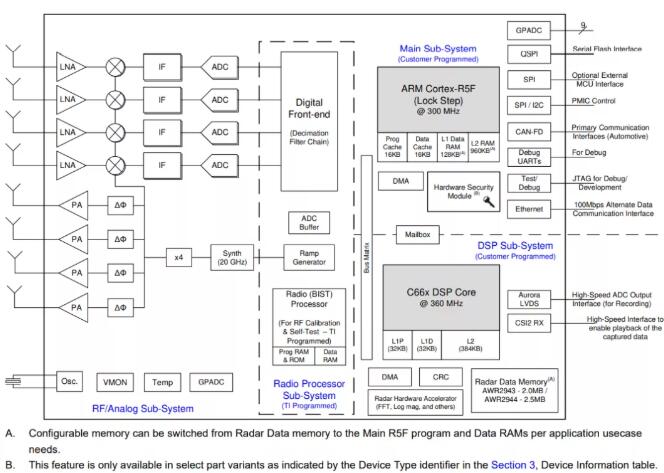
Functional Block Diagram(AWR2944)
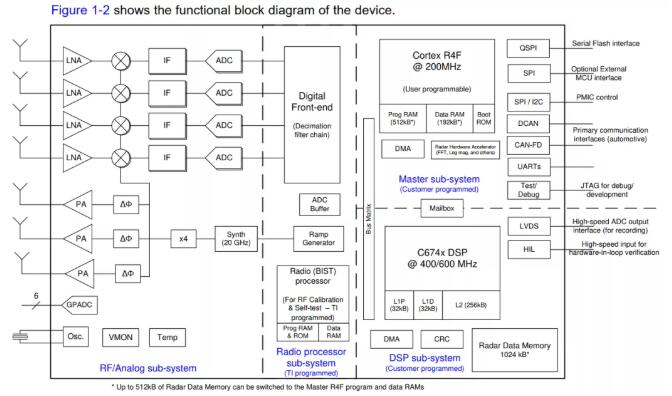
Functional Block Diagram(AWR1843)
It can be seen that, as the second-generation high-performance radar chip, AWR2944 has a lot of places to adjust and upgrade. But the function of parameters is only superficial after all, and we have to look at the deep logic behind these adjustments and upgrades.
I introduced Conti's next-generation angular radar in (Industry I Next-Generation Angular Radar-from SRR600). It is a basic requirement to realize high-precision perception of long-distance targets under the condition of large FoV, which poses new challenges to radar ranging performance, angular FoV, resolution and accuracy.
Compared with the previous generation, 944 integrates one more transmission channel to achieve higher angular resolution and accuracy, and also provides chip-level support for more complex antenna layout designs.
Usually, long-distance sensing is mainly solved by antenna design, which measures farther than the focused beam and compresses the FoV. It is difficult to achieve long-distance ranging under the condition of large FoV. One way is that multiple antennas transmit simultaneously, for example, four antennas transmit simultaneously, and the superimposed wide beam can measure farther under the condition of wide FoV. However, the problem of simultaneous transmission is that it is difficult for the receiver to reliably separate the superimposed beams. 944 adopts a brand-new DDM-MIMO channel separation scheme (detailed below), which realizes reliable channel separation on the basis of simultaneous transmission, and basically realizes high-precision perception of long-distance targets under the condition of large FoV. And almost all of this is realized by hardware accelerator (only a small amount of calculation is intervened by DSP), so TI upgraded HWA to 2.0.
At the same time, the RAM capacity is increased to balance the memory overhead caused by the increase of channel number and algorithm complexity. The addition of Ethernet interface is also to deal with the problem of increasing data volume such as radar output point cloud.
Among the first generation chips, 1642 is the first, and DSP is the absolute computing core, which is used for almost all signal processing and data processing tasks. MCU is basically only used for configuration, control and management, which is the basic positioning of ARM MCU by TI. Therefore, the treatment of MSS and DSS is not balanced, and the exact words of TI are: In most use cases the MSS is defined as a control domain while the DSS actually executes the DPC.
However, in the second generation, the leading 2944, the status of DSP was weakened, and the time-consuming and labor-intensive signal processing part was basically done by HWA. In fact, as long as you are willing, the whole RSP processing link is realized by HWA. TI also hopes that you can use HWA more, so it lowered the specification of DSP. The processing frequency of C66x is only 360MHz, which is much lower than that of the previous generation C67x. Moreover, ARM is strengthened, not only for configuration and control, but also for upper data processing. For example, tracking and classification can also be processed by ARM, which further shares the processing tasks of DSP, which is the reason for the decline of DSP specifications.
This kind of change is mixed, and we will talk about it at the end of the article.
Although the adjustment and upgrade of 2944 are rich, which brings a new radar experience, the cost of 2944 chip will not increase much due to the reduction of DSP specifications and the number of ADCs in the single-channel mixing scheme at the receiving end.
And software demo reference design. TI provides SDK and Toolbox adapted to 2944.
Toolbox contains 2944 reference design that meets the functional requirements of NCAP R79, and supports BSD, FCTA, LCA, etc. Demo realizes horizontal FoV ± 80° Distance measurement under 200m, angular resolution of 9.5° . More interestingly, TI added such an interesting sentence in the feature column of reference design: Builds customer confidence on mm wave device capabilities. It seems that millimeter wave radar is still relatively humble.
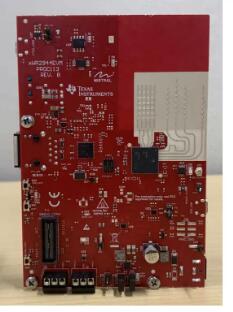
AWR2944 EVM
The combination of EVM and DCA1000 provides raw data acquisition capability to support the analysis of raw ADC data.
Equivalent array of MIMO layout of Demo board antenna is

Virtual Antenna Array
The antenna frequency band covers 76GHz to 81GHz, with a gain of 13dBi, 3dB a beam width level of 3 dB ± 30° pitch ± 3° 6dB beamwidth level ± 45° pitch ± 5°.
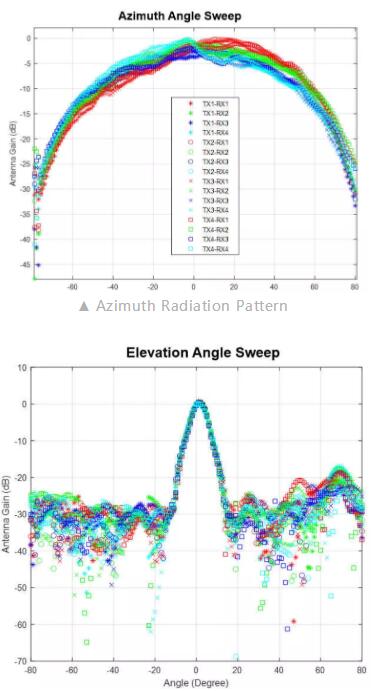
Elevation Radiation Pattern
After TI SDK 3.x, a brand-new SW Framework is designed, and concepts such as DPC, DPM and DPU are introduced, which makes the whole software architecture complex but the logic is clear, and developers can quickly start developing it. Framework is not the focus of this article, so I won't repeat it here. Let's talk about the core upgrade DDM-MIMO.
I have discussed MIMO channel separation technologies such as FDM, TDM and CDM in (MIMO channel separation of 4D radar). Different from TDMA, FDMA can realize simultaneous transmission, and determine the channel separation scheme by using the mapping relationship between the transmitter antenna and the frequency offset position.
Among them, FDM can be simply summarized by the following figure.
(a) If the frequency offset between channels to be separated is a multiple of Doppler resolution, it is DDMA;
(b) If the frequency offset between the channels to be separated is a multiple of the signal bandwidth after dechirp, it is RDMA;
(c) If the frequency offset between the channels to be separated is a multiple of the maximum beat frequency, it is BFD;
(d) If the frequency offset between channels to be separated is a multiple of chirp bandwidth, it is FT-FDMA.
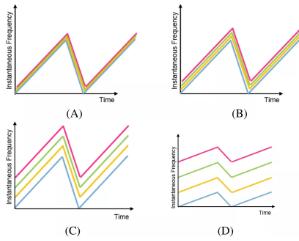
MIMO channel separation
Therefore, DDM can be considered as a case of FDM.
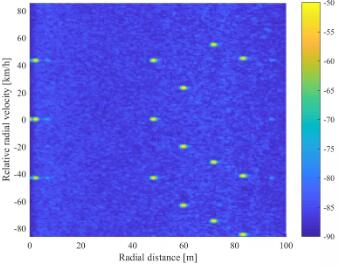
Range-Doppler map(DDM)
TI implements The empty-band DDMA, provides RangeProc DDMA DPU, and Doppler DDMA DPU constitutes the core module of DDMA. I have a brief look at DDMA Demodulation implemented by TI's current hardware, and the overall completion is still OK.
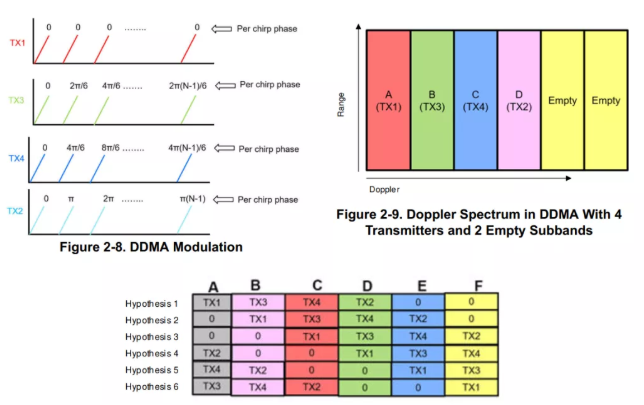
DDMA principle
It can be seen from DDMA modulation that DDM-MIMO requires a high level of phase shifter, and the precision of TI phase shifter also needs careful evaluation.

Object Detection Data Path Processing Chain
However, DDMA is not an easy solution. The potential problems of DDMA include, but are not limited to,
Phase calibration Peak aliasing Unbalanced amplitude
The following figure shows the measured results of demo, and its ranging performance, point cloud density, FoV and other effects are OK, which is indeed much higher than that of the first generation. Hope to be able to
“Builds customer confidence on mmWave device capabilities”。
The following figure shows the measured results of demo, and its ranging performance, point cloud density, FoV and other effects are OK, which is indeed much higher than that of the first generation.
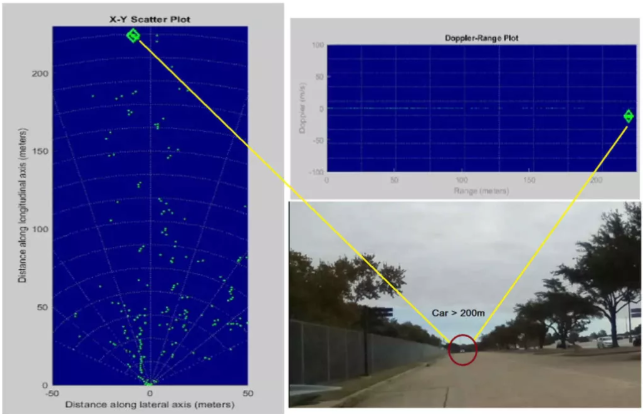
2944demo Test
Summarize
Let's take another step up and analyze what impact the release of TI 2944 may have on the vehicle radar industry.
If we only analyze the competitiveness of radar from the technical point of view, the most important thing lies in antenna, MMIC and algorithm. Chip manufacturers provide MMIC, and radar manufacturers gradually establish their own barriers due to the advantages of antenna and algorithm, and this state seems to change slowly.
1. Millimeter-wave radar is gradually changing from "difference of signal processing links" to "difference of data processing links", that is, difference of point cloud data processing methods. It advocates the use of TI HWA, solidifies many advanced signal processing algorithms, and users only need to access them according to their needs. The signal processing algorithms are being standardized, and the radar bottom standard is constructed.Reducing the processing frequency of DSP and increasing the core frequency of ARM can not only guide users to strengthen the use of HWA in disguise, but also help to balance the cost. TI also said:
The Hardware Accelerator block (HWA 2.0) supplements the DSS and MSS by offloading common radar processing such as FFT, Constant False Alarm rate (CFAR), scaling, and compression. This saves MIPS on the DSS and MSS, opening up resources for custom applications and higher level algorithms.
The battlefield of radar manufacturers is gradually changing to data processing, including tracking, target classification, scene understanding, edge AI, data fusion and so on.
2. I always think that signal processing is the most fascinating part of millimeter wave radar. Such a move will undoubtedly lead to weaker control of all intermediate links from ADC raw data output to radar point cloud data output by radar manufacturers. Lower flexibility of RSP layer. It will further lower the threshold of radar technology and break some technical barriers of original radar manufacturers. It can be seen that the chip suppliers will have greater and greater influence on radar manufacturers, and the "equal rights" strategy at the top level of chip manufacturers will further reduce the product differences among radar manufacturers, which is bound to enter low-price competition.
As for the upgrade direction of the follow-up radar, I think the signal processing part will be partially diluted under the influence of chip manufacturers, and will still be strengthened by HWA, and the RSP part may eventually be a standard product. What kind of application do you need? Just configure the registers, and the competition may be more and more concentrated on the upper data processing. It is also possible to integrate the brand-new AI Engine. To some extent, millimeter-wave radar will be more and more like laser radar except frequency band.









Site Map | 萨科微 | 金航标 | Slkor | Kinghelm
RU | FR | DE | IT | ES | PT | JA | KO | AR | TR | TH | MS | VI | MG | FA | ZH-TW | HR | BG | SD| GD | SN | SM | PS | LB | KY | KU | HAW | CO | AM | UZ | TG | SU | ST | ML | KK | NY | ZU | YO | TE | TA | SO| PA| NE | MN | MI | LA | LO | KM | KN
| JW | IG | HMN | HA | EO | CEB | BS | BN | UR | HT | KA | EU | AZ | HY | YI |MK | IS | BE | CY | GA | SW | SV | AF | FA | TR | TH | MT | HU | GL | ET | NL | DA | CS | FI | EL | HI | NO | PL | RO | CA | TL | IW | LV | ID | LT | SR | SQ | SL | UK
Copyright ©2015-2025 Shenzhen Slkor Micro Semicon Co., Ltd